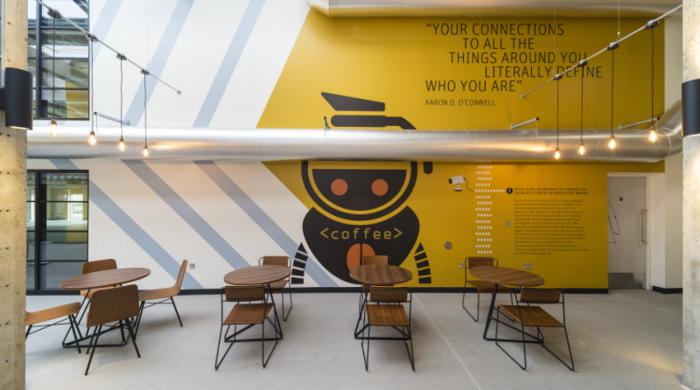Whilst home working provides a necessary course of action at present, there are undoubtable issues surrounding it. Many will not have adequate ergonomically designed furniture to meet their physical requirements and will lack the suitable technological software and equipment. For some working from home may increase feelings of isolation and find it disrupts team cohesion and reduces innovation. A well-designed office will increase employee attraction and morale; it can boost engagement and productivity.
It is clear that the flexibility of when and where to work is a key factor of interest for employees and as a result organisations need to assess the importance of their workplace. Purpose driven work is harnessed by connecting the right people and this is more seamlessly achieved certainly in the early stages of working together in the same physical environment. Management can take strategic decisions on which teams should be drawn together by observations they make in which people spark off each other and work well together and vice versa as it can become automatically obvious as to which groups don’t gel. The collaboration, teamwork and connectivity that a healthy working environment imbues is vital to the growth and sustainability of a company.
Beyond the all-important people dynamics which allow a company to thrive, we should also consider the following factors:
What functions have to be carried out in the workplace?
What activities should be given a preference for being carried out on site?
What work tasks benefit from being in the workplace?
What work tasks are better operated virtually?
How can the number of employees returning to the workplace be minimised to those whose work activities are essential to being in the workplace?
Examine how the workplace experience can offer physical and mental wellbeing initiatives in order to negate and fears or anxiety.
The novelty of working from home has provided us all with an experience of what can be achieved remotely but, there is no getting away from the fact that most of us have experienced zoom weariness and feel less connected, nuances that are perceived in conversation in the same physical space are not distinguishable viewed on a screen which means vital considerations are often ignored. The same may be said of those in the office who may sit through a meeting and not raise their hand but, afterwards speak to a trusted colleague to offer their opinion or their apprehension to partake is picked up on by an observant co-worker. The workplace gives a forum for this interaction and ability to observe and develop individuals. Mentoring and management of employees is compromised without a central hub and workplace to operate from.
This is our opportunity to create cost effective and life enriching environments from which to work; where the needs of the employees are at the forefront and allow for lifestyle choices which relieve stress on the individual and ultimately potentially provide employers with lower overheads and higher productivity rates. Establishing an alluring workplace is central to this model and in developing these offices of the future we need to focus not only on the current requirements given the recent lockdown and global situation but, also think to the future by becoming more flexible to cope with changes, more ecological and sustainable, more in tune with the requirement to connect people physically as ways of working may become more remote. The workplace needs to be a hub where employees feel valued, are able to connect and interact with others, learn, challenge, create and produce. Without this central forum and spark produced by the fusion of individuals working together companies will lose their heartbeat and employees will feel disconnected from the culture of the company. In creating workplaces that celebrate the employees we will provide them with a sense of belonging to feel part of something bigger than themselves.
Pictured: Wall art within The Works, Unity Campus: 63,000sq ft of flexible, modern workspace with suites available from 7,500 sq ft www.unitycampus.co.uk
